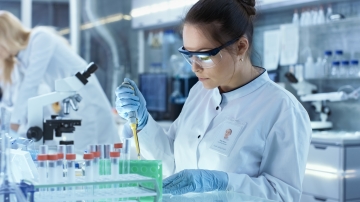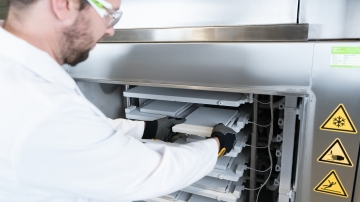Cryovessels in Biopharmaceutical Manufacture: When Does the Tank Run Out?
Table of contents
ShowAmong the key innovations of the biopharmaceutical industry over recent decades, the cryovessel stands out as a critical component in the process of freezing biopharmaceuticals. In this blog post, we delve into the background of cryovessels and their applications in bioprocessing. Additionally, we will explore the advantages and disadvantages of using cryovessels in biopharmaceutical production, comparing them with advanced single-use technologies, such as plate-based freezing and thawing. In the rapidly evolving landscape of biopharmaceutical manufacture, the scalable and controlled freezing that plate-based freezers facilitate has emerged as a game-changer.
Background of Cryovessels in Biopharma
Cryovessels are durable, multi-use containers, usually made of aluminum or stainless steel, that are meticulously designed to handle and store biopharmaceutical products during essential freezing, thawing, and cryoconcentration processes. Cryovessels comprise an inner, storage vessel and an outer, protective vessel; the two are separated by a tiny gap that has been evacuated to create an insulating vacuum between the two vessels. Engineered to withstand extremely low temperatures, cryovessels are crafted from high-quality materials that guarantee the utmost integrity and purity of the stored substances. Widely embraced as an established bioprocess solution, cryovessels serve as a reliable platform for preserving bulk drug substances, trusted by numerous biomanufacturers. Cryovessels are also used for storing and transporting many of the raw materials needed in the biopharmaceutical industry, such as cells and tissue samples, while also retaining the biological activity of these materials.
Despite the key goal of minimizing contamination risks during the use of cryovessels, the possibility remains of compromising product quality during the freezing process. The open handling of cryovessels exposes the contents to contaminants, potentially impacting the purity of the stored biopharmaceuticals. Additionally, as they are intended to be used multiple times, these vessels require intensive cleaning and sterilization procedures to ensure safe reuse and avoid contamination, which can be time-consuming and resource-intensive.
Importantly, when comparing reusable cryovessel technologies with newer, single-use technologies, the former is found to be less sustainable. Substantial quantities of water, chemicals, and energy are required for the production and maintenance of aluminum or stainless-steel equipment, contributing to a larger environmental footprint than the manufacture and use of single-use technologies.
Single-use technologies therefore offer a more environmentally friendly alternative, reducing resource consumption and minimizing the generation of waste [1]. As the biopharmaceutical industry seeks more sustainable solutions, the adoption of single-use technologies presents an opportunity for reduced environmental impact while simultaneously enhancing bioprocessing efficiency.

Applications of Cryovessels in Bioprocessing
The applications of cryovessels in bioprocessing are many and diverse. They play a pivotal role in the preservation and transportation of sensitive biopharmaceutical products, in addition to buffer and media solutions that must be added throughout bioprocessing. With the frozen storage and transportation of large volumes of product, cryovessels are also used for cold-chains in the microbial fermentation industry, the commercial production of monoclonal antibodies and antibody-drug conjugates, and more. In large-scale biopharmaceutical manufacture, cryovessels have become an established asset for freezing and thawing processes involving up to 300L per batch.
It is important to note, however, that using conventional freezing methods for bulk drug substances has the drawback of compromising product quality due to the bulky structure of cryovessels. This leads to the clear effect of the phenomenon known as cryoconcentration, which is where liquids in cryovessels tend to freeze from the outside in, causing active pharmaceutical ingredients to be pushed toward the center of the cryovessel [2]. This process can induce greater stress-related damage and reduce product viability, making the use of cryovessels less favorable in comparison with the use of flat geometries, such as the smaller water columns found in single-use bags.
Plate-Freezing: The Future of Freezing Biopharmaceuticals
While cryovessels have undoubtedly led to enhanced bioprocessing, recent advances in freezing technologies have further optimized the freezing of biopharmaceuticals. One such innovation is the introduction of plate-based freezers, which is more than just an alternative to traditional bulk drug substance freezing.
Plate-based freezers employ a unique design, through which biopharmaceuticals are protected in both primary and secondary, allowing them to be evenly spread and rapidly frozen on the large surface areas afforded by plates. This allows for a much quicker and more uniform freezing process, minimizing the formation of ice crystals and reducing the risk of protein denaturation. Compared with conventional freezing methods, plate-based freezing ensures greater product integrity and, consequently, improved therapeutic efficacy due to the absence of cryoconcentration during the freezing process.

Plate-based freezing not only maintains higher concentrations of proteins post-thaw but also offers better control over solute concentration changes during freezing [3], further emphasizing its superiority over traditional freezing techniques employed in the biopharmaceutical cold-chain.
The future of freezing biopharmaceuticals is likely to see a broader adoption of plate-based freezing methods. Manufacturers will embrace the benefits of reduced batch-to-batch variability, greater product yields, and, ultimately, improved patient outcomes. The integration of advanced freezing technologies, such as plate-based freezers, into existing bioprocessing workflows will drive innovation and reshape the landscape of biopharmaceutical manufacturing.
The End of Cryovessels?
It is many decades since cryovessels emerged as a groundbreaking solution in the biopharmaceutical industry, enabling the safe and efficient storage of bulk drug substances. However, the introduction of plate-based freezing methods has further advanced the technology available for the freezing of biopharmaceuticals, offering improved product quality and consistency.
As the biopharmaceutical sector continues to evolve, it is evident that plate-based freezing will become an indispensable asset for manufacturers seeking to enhance product quality and process efficiency. By embracing the advantages of advanced freezing technologies, the industry is poised to revolutionize bioprocessing and create a more promising future for patients worldwide.
More information
- Budzinski, K. et al. Streamlined life cycle assessment of single use technologies in biopharmaceutical manufacture. New BIOTECHNOLOGY 68 (2022) 28–36.
- Minatovicz, B., et al., Freeze-concentration of solutes during bulk freezing and its impact on protein stability. Journal of Drug Delivery Science and Technology, 2020. 58: p. 101703.
- Jenewein, R., How Controlled Freezing becomes Reality Impact of Ice Front Growth Speed on Scalability of Freezing Protein Solutions (RoSS.pFTU white paper). 2022, Single Use Support.
References
- Budzinski, K. et al. Streamlined life cycle assessment of single use technologies in biopharmaceutical manufacture. New BIOTECHNOLOGY 68 (2022) 28–36.
- Minatovicz, B., et al., Freeze-concentration of solutes during bulk freezing and its impact on protein stability. Journal of Drug Delivery Science and Technology, 2020. 58: p. 101703.
- Jenewein, R., How Controlled Freezing becomes Reality Impact of Ice Front Growth Speed on Scalability of Freezing Protein Solutions (RoSS.pFTU white paper). 2022, Single Use Support.












